![]()
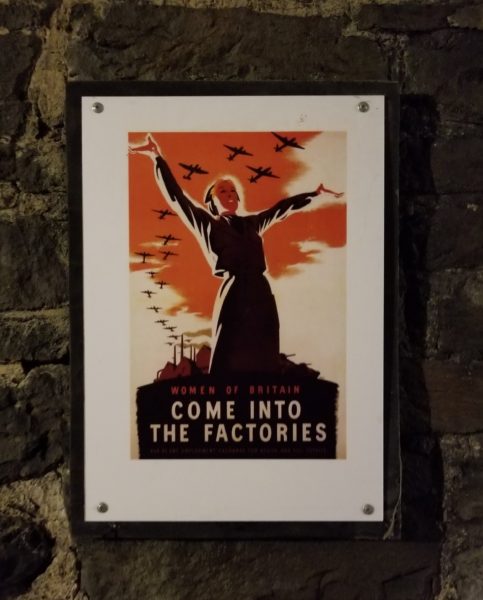 I intended to post this way back in March, in observance of Women’s History Month this year, but obviously that did not happen – in the midst of moving and other entanglements, I definitely did not reach that goal. However, here is what I wanted to share with you. In this blog post, I highlight the dedication of women who supported the World War II (WW2) war efforts of the Allied Forces. Manufacturing jobs in many countries became available to women, as industries transitioned to war production.
I intended to post this way back in March, in observance of Women’s History Month this year, but obviously that did not happen – in the midst of moving and other entanglements, I definitely did not reach that goal. However, here is what I wanted to share with you. In this blog post, I highlight the dedication of women who supported the World War II (WW2) war efforts of the Allied Forces. Manufacturing jobs in many countries became available to women, as industries transitioned to war production.
In September 2021, Andy and I were finally able to use the credit we had pending with British Airways to fly to the United Kingdom (UK) for a trip that had to be postponed, due to the pandemic shutdown. It was a little logistically difficult, but I will refrain from droning on about all of the covid testing and red tape we had to go through. Anyway, we took the train from London to Cardiff in Wales, and one of the first places we visited was Cardiff Castle. It was used as a bomb shelter during the war, and that was where I saw this “Come Into the Factories” poster that encouraged women in the UK to pick up manufacturing jobs, while the men were deployed to the front lines of the war. 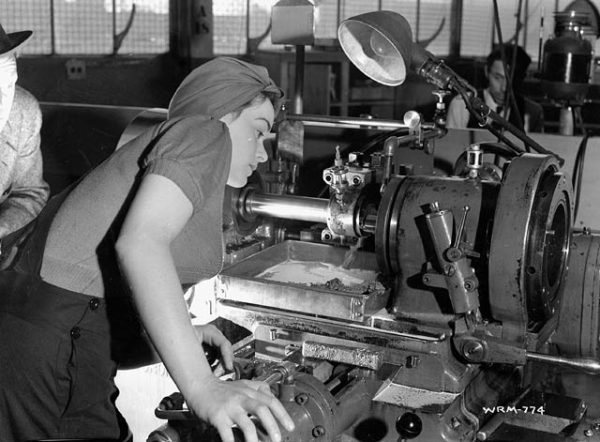
Of course, women in the other Allied countries were making the same sacrifices that US women were (or more actually) and filling in for the men who were fighting. But I wasn’t previously familiar with WW2 recruitment posters and photographs of women who went to work in factories as part of the war effort.
For example, I did not know about Veronica Foster, a Canadian woman who went to work in 1941 making Bren Light machine guns for the John Inglis Company. That same year, she was photographed by the National Film Board, as part of a campaign to encourage Canadian women to go to work for the war effort. She became known as “Ronnie the Bren Girl,” and she predates the well recognized We Can Do It! cultural icon in the United States by about two years.
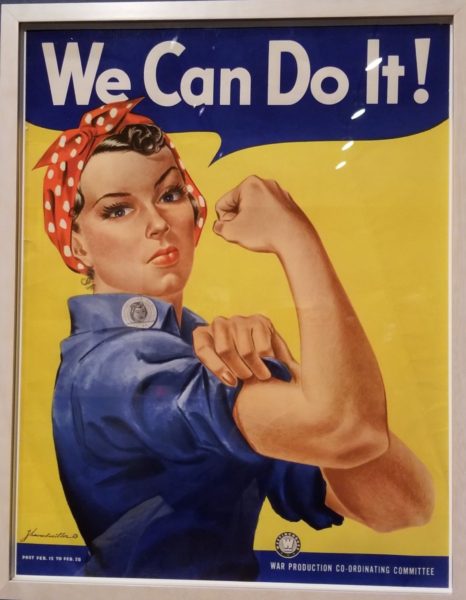 In 1942, the US government established the Office of War Information (OWI) that distributed information to inspire US women to go into the factories – to take up jobs to produce urgently needed ammunition, airplanes, and other military and medical supplies for the troops abroad. In addition, the OWI encouraged enlisting in the armed forces, planting victory gardens, buying war bonds, and rationing of particular foods. Because the success of the Allied Forces was not guaranteed and the resources needed were overwhelming, this government office implemented propaganda and adverstisements to rally the American people behind the war effort. In these campaigns, they used posters, pamphlets, news reels, and radio shows, to increase the participation of women in war efforts. The OWI also produced a Magazine War Guide that gave ideas, information, and slogans to magazine publishers.
In 1942, the US government established the Office of War Information (OWI) that distributed information to inspire US women to go into the factories – to take up jobs to produce urgently needed ammunition, airplanes, and other military and medical supplies for the troops abroad. In addition, the OWI encouraged enlisting in the armed forces, planting victory gardens, buying war bonds, and rationing of particular foods. Because the success of the Allied Forces was not guaranteed and the resources needed were overwhelming, this government office implemented propaganda and adverstisements to rally the American people behind the war effort. In these campaigns, they used posters, pamphlets, news reels, and radio shows, to increase the participation of women in war efforts. The OWI also produced a Magazine War Guide that gave ideas, information, and slogans to magazine publishers.
One widely known image is this iconic “We Can Do It!” motivational poster that later became largely associated with feminism. The “We Can Do It!” poster, by graphic artist J. Howard Miller, was not circulated by the OWI. Instead, it was promoted by the War Production Coordinating Committee of Westinghouse Corporation and was displayed only to Westinghouse Corporation employees in the Midwest, during a two-week period in February 1943, for motivation purposes. It then fell into the background of post-war America for decades, only later becoming an “allegorical cultural icon” of WW2.
 The OWI propaganda was also reinforced by popular culture, especially popular music. In 1942, a tune called “Rosie the Riveter” was composed by Redd Evans and John Jacob Loeb, and a clip from the lyrics is:
The OWI propaganda was also reinforced by popular culture, especially popular music. In 1942, a tune called “Rosie the Riveter” was composed by Redd Evans and John Jacob Loeb, and a clip from the lyrics is:
All the day long, whether rain or shine,
She’s a part of the assembly line.
She’s making history,
Working for victory,
Rosie (Brrr)* the Riveter.
Keeps a sharp lookout for sabotage,
Sitting up there on the fuselage.
That little frail can do,
More than a male can do,
Rosie (Brrr)* the riveter.
*(Brrr) is a ukulele imitation of the noise of riveting machines.
This song and the propaganda posters worked in tandem to create an emerging emblem of working women during the war. By 1943, more than 310,000 women were employed in the US aircraft industry alone. And overall, the number of American women working outside the home grew from 14 million in 1940 to 19 million in 1945, an increase from 26% to 36% of the work force, during the war years. Of course, many women were already working low-paying jobs before the war, and some were able to fill in at the factories for higher wages.
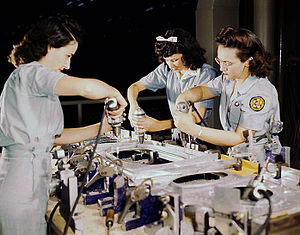
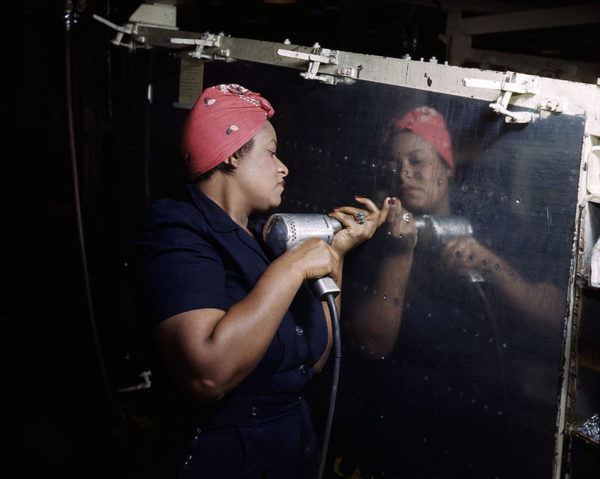 Here are a couple of photographs of women working on the assembly lines that I love. Many women who worked during WW2 felt fulfillment in their jobs and a sense of patriotic accomplishment.
Here are a couple of photographs of women working on the assembly lines that I love. Many women who worked during WW2 felt fulfillment in their jobs and a sense of patriotic accomplishment.
It should also be pointed out that around 350,000 American women served in uniform, both at home and abroad, volunteering for the Women’s Army Auxiliary Corps (later renamed the Women’s Army Corps,) the Navy Women’s Reserve, the Marine Corps Women’s Reserve, the Coast Guard Women’s Reserve, the Women Airforce Service Pilots, the Army Nurses Corps, and the Navy Nurse Corps.
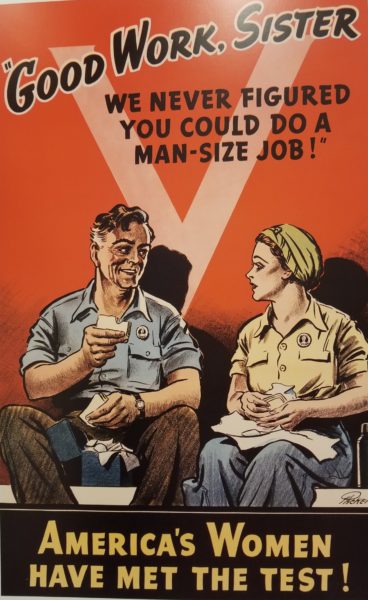 Then, beginning as early as 1944, the propaganda in the US began changing. Here is a condescending example of the new type of propaganda that I think speaks clearly to the historic social forces and mores of this transition to a peaceful post-war time period. No attempt at subtlety here – just a back-handed compliment. As the men were returning to the homefront, women were expected to go back to working as housewives or to return to more traditional work for women, such as clerical, administration and service positions. The overall percentage of US women working outside the home fell from 36% to 28% by 1947. Women did not reenter the job market in such large numbers again until the 1970s.
Then, beginning as early as 1944, the propaganda in the US began changing. Here is a condescending example of the new type of propaganda that I think speaks clearly to the historic social forces and mores of this transition to a peaceful post-war time period. No attempt at subtlety here – just a back-handed compliment. As the men were returning to the homefront, women were expected to go back to working as housewives or to return to more traditional work for women, such as clerical, administration and service positions. The overall percentage of US women working outside the home fell from 36% to 28% by 1947. Women did not reenter the job market in such large numbers again until the 1970s.
Reference 1: Vergun, David, “Rosie the Riveter Inspired Women to Serve in World War II,” US Department of Defense, March 2019.
Reference 2: “Rosie the Riveter,” Wikipedia, public domain.
Reference 3: Gormly, Kellie, “Rosie the Riveter Gets Her Due 75 Years After the End of World War II,” Smithsonian Magazine, December 2020.
Reference 4: “Rosie the Riveter: Real Women Workers in World War II,” Library of Congress, transcript of video by Sheridan Harvey.
Reference 5: “Veronica Foster,” Wikipedia, public domain.
Image 1: “Come Into the Factories,” United Kingdom WW2 recruitment poster, Cardiff Castle, photo credit Julie Henkener, September 2021.
Image 2: Veronica Foster, Making Bren Light Machine Guns for John Inglis Company, Wikimedia Commons, public domain.
Image 3: “We Can Do It!” Westinghouse WW2 motivational poster, National Archives and Records Administration, NARA 535413, public domain. Photo credit Julie Henkener, January 2020 at Norman Rockwell Exhibit, Museum of Fine Arts Houston.
Image 4: “Rosie the Riveter,” cover image on sheet music, 1942.
Image 5: Riveter working on a WW2 Vultee A-31 dive bomber aircraft, Nashville, Tennessee, 1943, Wikimedia Commons, public domain.
Image 6: Drilling a wing bulkhead section for a transport aircraft, at the Consolidated Aircraft factory, Fort Worth, Texas, October 1942, Wikimedia Commons, public domain.
Image 7: “America’s Women Have Met the Test,” Library of Congress Item 97515638, public domain. Photo credit Julie Henkener, January 2020 at Norman Rockwell Exhibit, Museum of Fine Arts Houston.
![]()















Leave a Reply
Join the conversation by submitting a comment to this blog post below.